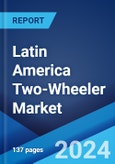Two-wheeler vehicles mainly include scooters, motorcycles, and mopeds. The high adoption rate of two-wheelers can be primarily attributed to their enhanced fuel efficiency, compact design, cost-effectiveness, and lower carbon emissions. Two-wheelers are one of the most versatile modes of transportation, particularly for easy maneuvering through congested roads.
The prevalent trend of personal vehicle ownership, particularly among the millennial population, is driving the demand for two-wheelers in Latin America. Additionally, the increasing number of women commuters, especially across Brazil, Mexico, Argentina, etc., is also augmenting the sales of two-wheelers. In line with this, several regional manufacturers are launching specialized vehicles designed to cater to the preferences of the women population. Moreover, the growing penetration of various international two-wheeler OEMs in the region is also driving the market growth.
In line with this, improving consumer living standards supported by their rising disposable income levels are catalyzing the demand for advanced and highly-powered motorcycles and scooters. Furthermore, the rapid launch of new, attractive two-wheeler models equipped with the latest technologies at affordable prices is also propelling the market in Latin America. Apart from this, the rising environmental concerns towards increasing vehicular pollution levels have augmented the need for electric two-wheelers. In the coming years, the growing number of government initiatives for promoting the adoption of electric and hybrid two-wheelers will continue to drive the market growth in Latin America.
Key Market Segmentation
This report provides an analysis of the key trends in each sub-segment of the Latin America two-wheeler market report, along with forecasts at the regional and country levels from 2024-2032. The report has categorized the market based on vehicle type, fuel type, engine capacity and technology.Breakup by Vehicle Type:
- Motorcycle
- Scooter
- Moped
Breakup by Fuel Type:
- Gasoline
- Electric
Breakup by Engine Capacity:
- Less Than 100cc
- 100-125cc
- 126-250cc
- 250-500cc
- More Than 500cc
Breakup by Technology:
- Manual
- Automatic
Breakup by Country:
- Brazil
- Mexico
- Colombia
- Argentina
- Peru
- Ecuador
- Chile
- Others
Competitive Landscape
The competitive landscape of the industry has also been examined with some of the key players being Bajaj Auto Limited (Bajaj Group), Dafra Motos (Itavema S/A), Honda de México S.A. de C.V. (The Honda Motor Company Ltd.), Kawasaki Motors Manufacturing Corp. U.S.A. (Kawasaki Heavy Industries, Ltd.), Lifan Industry (Group) Co. Ltd, Motomel S.A., Shineray Do Brasil SA, Suzuki Motor Corporation, TVS Motor México (TVS Motor Company Limited), Wanxin Group International, Yamaha Motor de México SA de CV (Yamaha Motor Co. Ltd.), Zanella Hnos & Cia SACIFI., and Zongshen Automobile Industry Manufacturing Co. Ltd. (Zongshen Industry Group Co. Ltd.).Key Questions Answered in This Report
1. What was the size of the Latin America two-wheeler market in 2023?2. What is the expected growth rate of the Latin America two-wheeler market during 2024-2032?
3. What are the key factors driving the Latin America two-wheeler market?
4. What has been the impact of COVID-19 on the Latin America two-wheeler market?
5. What is the breakup of the Latin America two-wheeler market based on the vehicle type?
6. What are the key regions in the Latin America two-wheeler market?
7. Who are the key players/companies in the Latin America two-wheeler market?
Table of Contents
Companies Mentioned
- Bajaj Auto Limited (Bajaj Group)
- Dafra Motos (Itavema S/A)
- Honda de México S.A. de C.V. (The Honda Motor Company Ltd.)
- Kawasaki Motors Manufacturing Corp. U.S.A. (Kawasaki Heavy Industries Ltd.)
- Lifan Industry (Group) Co. Ltd
- Motomel S.A.
- Shineray Do Brasil SA
- Suzuki Motor Corporation
- TVS Motor México (TVS Motor Company Limited)
- Wanxin Group International
- Yamaha Motor de México SA de CV (Yamaha Motor Co. Ltd.)
- Zanella Hnos & Cia SACIFI
- Zongshen Automobile Industry Manufacturing Co. Ltd. (Zongshen Industry Group Co. Ltd.)
Methodology

LOADING...
Table Information
| Report Attribute | Details |
|---|---|
| No. of Pages | 137 |
| Published | April 2024 |
| Forecast Period | 2023 - 2032 |
| Estimated Market Value ( USD | $ 12.1 Billion |
| Forecasted Market Value ( USD | $ 36.2 Billion |
| Compound Annual Growth Rate | 12.9% |
| Regions Covered | Latin America |
| No. of Companies Mentioned | 13 |








